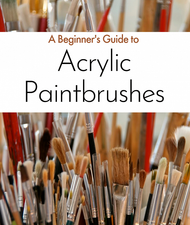Guide to Paintbrushes for Acrylic Painting
Posted by DecoArt on Mar 31st 2021
One of the most difficult things for beginning painters is simply knowing what they need to start. If you want to learn how to paint acrylics are a wonderful medium for beginners. You don’t need any special tools to start painting with acrylics, all you need are some paintbrushes, quality acrylic paints, and a canvas to get started.
While it sounds simple, your first trip to the craft store may feel overwhelming! You can find yourself looking down the paint aisle at a loss for what to choose. What's the difference between a liner and a flat brush? Do you really need multiple sizes? And should you get synthetic or natural bristles? This article is a guide to the essential paintbrushes used for acrylic painting. Read on to learn the basics and start your painting journey struggle-free!

Basic Paintbrush Shapes
Knowing the different brush shapes and how to use them is key to improving your painting technique. For example, liner brushes can help you paint thin and precise lines whereas a flat brush is ideal for bold/broad strokes. Having a variety of brushes in different shapes and sizes opens up different painting techniques and styles for you to try.
Below we've listed the most common paintbrush shapes out there and how they can be used. Feel free to save this graphic to refer back to until you're comfortable with using each brush.


Try practicing by painting simple strokes with each brush until you're comfortable using it. Experiment with different angles, levels of pressure, and amounts of paint. Practice will help you get used to the unique feel of each paintbrush.
Paintbrush Sizes
Paintbrushes come in a variety of sizes indicated by a number, usually on the handle. The numbers can start from 000 and go all the way up to 20. Be aware that different brands of paintbrushes in the same size can look different.

Each size of a paintbrush has its own purpose. Smaller brushes are used for detail work and fine lines, mid-sized brushes are the most versatile, and larger brushes can be used for washes or painting large areas.
For beginners, try starting off with mid-sized brushes (sizes 6 to 8) in different shapes. Once you know more about your painting style you can branch out to smaller or larger brushes depending on your needs.

Anatomy of a Paintbrush
Did you know each part of the brush has a different name? DecoArt’s Art For Everyone Learning Center has free videos on all the paintbrush basics, including paintbrush anatomy.
Paintbrush Bristle Types
Paintbrush bristles mostly fall into two common categories, natural and synthetic. Natural bristles will be made of a material such as hog bristle or soft sable whereas synthetic bristles will be made from nylon and polyester.
There are pros and cons to each bristle type. Natural bristles can handle heavier paint easier and are better at holding their shape over time. This makes them a favorite for oil painters. However, acrylic paints can damage the natural fibers and these brushes cannot handle sitting in water which may make them too finicky for beginners.

On the other hand, synthetic bristles won’t break down in acrylic paint and don’t mind sitting in water. They don’t hold their shape as well as natural bristles, but can still last a long time if properly cared for. Overall, if you’re using brushes mainly for acrylic painting, synthetic brushes are the way to go.

How To Store and Clean Paintbrushes
A common mistake beginners make is letting the paint dry on their brushes. Dried acrylic paint can quickly ruin even the nicest set of brushes, so always keep water on hand to rinse off your brushes after each use. Make it a habit to wash your brush clean of paint and smooth it back into its original shape once you are done using it. Using a brush cleaner will maintain the soft delicate brush bristles and keep your brushes lasting longer.
This video on brush care is a great resource for art and craft painters who want to take good care of their brushes.
What Paintbrushes You Need to Get Started
This may seem like a lot of information, but don’t get overwhelmed! Here’s our recommended list of paintbrushes for beginning painters looking to get started.
If you're looking to get started painting DecoArt has all the supplies you need! Our Designer Brush Sets are a great starting point for aspiring painters, and our new Acrylic Paint Sets come in a variety of color sets to help you get a jumpstart on your collection. Click here to check out all our painting supplies.
Next Steps
Now that you know all about paintbrushes it’s time to pick one up and start painting! Our video on basic brush strokes can help you practice with your new brush set.
If you're new to painting or looking to refresh your skills, our Art For Everyone Learning Center is a wonderful resource. We upload free videos on a variety of techniques and other art basics to help you learn to paint right at home. You can also check out the DecoArt blog where we post new tutorials and projects every week or the DecoArt Project Gallery.
Happy making! From your friends at DecoArt.


